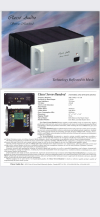D
Deleted member 50971
Guest
Nice gear, and it’s interesting to see the mix of gear you guys are using. I also have a couple pieces of tube gear, one is a Fisher integrated tube amp from 1964, I believe this was the last full tube amplifier that they did, and in 1965 they went all solid state.Well the MOJO doesn't have enough current to drive the Aeon probably. This is what I have found out with my Aeon. Many things can drive it, but the sound isn't full without a really proper high current amplifier.
With the MOJO being a portable device; it likely lacks that current.
For the tube amp; micro details will be lost and everything would be smoother. Some people like this sound but still, it's lacking in detail..
I have noticed for the Aeon though that in order to have good lows and mids; current output needs to be high. Otherwise it will have screeching highs and no body in the mids unless the volume is up way too high.
I specifically use a THX789 as my daily amp for this reason. When I have even been testing with my Geshelli Archel2 pro this last week (due to testing new DACs) I can tell the difference between the Geshelli and the 789.
The difference isn't immediately obvious and it depends on the songs. But a song with a lot of low frequencies will make me turn the volume up and then back down for the highs (sometimes in the same song, which happen a often in trance music) because the lows will be so quiet. The 789 has a more "consistent" volume and I won't need to turn it up or down.
This doesn't happen with every headphone though and the overall resolution of details is good on both amps and dacs (D70S + 789) & (SU-8S + Archel2).
To me as sinad goes down, highs are cut off. Either with the highest frequencies not being rendered properly or being blended into other frequencies. Certain background details from songs are lost the lower you go, or may be harder to make out. I notice also a harshness which can come with some Cymbals or "Slaps" (from electronic music), same with certain violin notes (the violin IMHO is the destroyer of low SINAD devices, as it has looooong notes at sometimes higher frequencies).
Since you have an Aeon X; it should be very similar to my Aeon Flow Closed. Try out what I mentioned and see if you can hear a difference if you like.
There are some cheap switches on Amazon too, where you can switch two amps. However you will need some controlled listening first to be able to distinguish details to hear quality with before you attempt to abx your system.
Another is a Tubes4hifi SP-14 preamp that I had built recently, and that is just great sounding and enjoyable to use.
I read your description, but wanted to ask you, do you feel that any of your tube gear sounds any different that it’s solid state counterpart?



